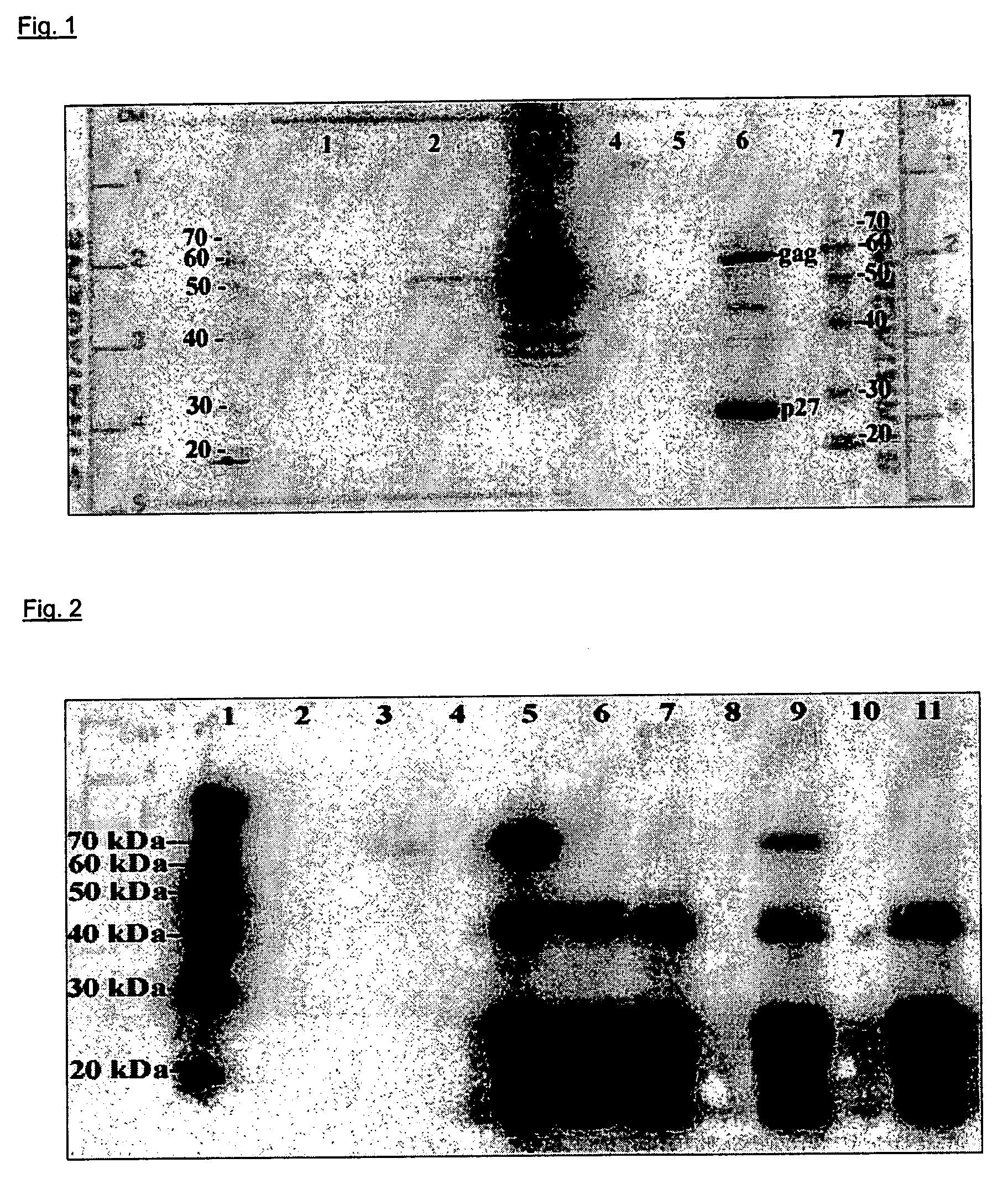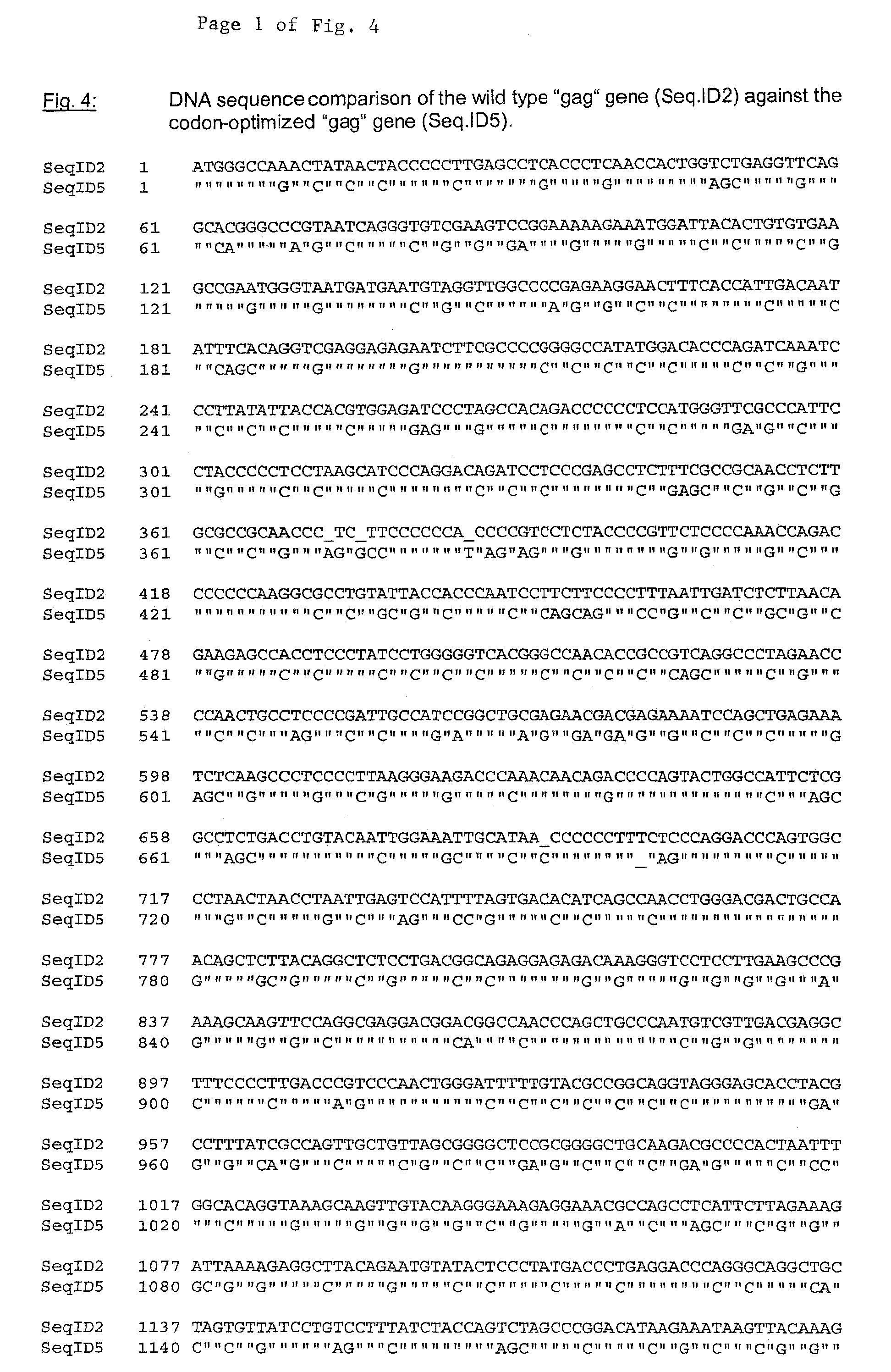Vaccine against oncovirus infections such as infections by feline leukosis virus of the cat
a technology of vaccines and oncoviruses, which is applied in the field of vaccines against oncovirus infections such as feline leukosis virus infections of cats, can solve the problems of inability to effectively treat felv infections leading to eradication of the disease, high side effects, and inability to inactivate, and achieve the effect of excluding the risk of fibrosarcoma
- Summary
- Abstract
- Description
- Claims
- Application Information
AI Technical Summary
Benefits of technology
Problems solved by technology
Method used
Image
Examples
example 1
Wild Type (WT)-Sequences
[0120]The wild type sequences of the selected antigens, especially the “gag” gene, were obtained from the blood of infected cats. The DNA sequence of the “env” WT is given in SEQ ID NO: 1 (NCBI data base, Acc. No.: M12500), for the “gag” WT in SEQ ID NO: 2. The corresponding amino acid sequences are given in SEQ ID NO: 3 (“env”) and SEQ ID NO: 4 (“gag”).
[0121]Primer for “gag” WT
[0122]In order to remove two Eco31I restriction sites, 3 PCR with the following mutation primers were performed:
[0123]
gag-mut1-rneu (SEQ ID NO: 12):AATTAAGAGCTCCACGTCTCCCCCCGCTAACAGCAACTGGCGgag-mut2-I (SEQ ID NO: 13):AATTAAGAGCTCCAGGTCTCCGGGGCTCCGCGGGGCTGCAAGACGgag-mut3-r (SEQ ID NO: 14):AATTAAGAGCTCCACGTCTCCTTCCCTTTTGTTGTATATCTTTTCTGCgag-mut4-I (SEQ ID NO: 15):AATTAAGAGCTCCAGGTCTCCGGAAACCCCAGAGGAAAGGGAAGAAAG
[0124]After ligation of the three sequences thus obtained, a PCR was performed with the primers:
[0125]
Felvgag-I (SEQ ID NO: 16):CGGATAAGGTACCATGGGCCAAACTATAACTACCFelvgag-r (SEQ ID ...
example 2
[0128]The codon usage table for cats was obtained from the codon usage database maintained by the Kazusa DNA research Institute, located in Kisarazu, Japan. For every amino acid of the two WT sequences, the codon used most frequently was employed. The following restrictions to this rule were used: If an amino acid was present more than three times in sequence, from the fourth one onwards, the second most frequent codon was used. This was meant to avoid the sudden extreme depletion of the tRNAs and to assure the efficacy of transcription.
[0129]In order to avoid uncontrolled immune stimulatory effects, sequences with a C and immediately following G were avoided. In order to avoid restriction sites for Eco31I, KpnI and SacI, all sequences of the base sequence GAGCTC, GGTACC, GGTCTC and GAGACC were removed by choosing alternative, also frequently used codons.
example 3
Cloning of FeLVenv
[0130]Oligonucleotides of a length between 18 and 28 bases were purchased (TibMolbiol). In total, 51 oligonucleotides were joined by annealing and ligation. The overlap was 4 bases. It was assured that any overlap occurred only once and was not palindromic. Every single oligonucleotide was hybridized strand against antisense strand, by heating the single strands (strand and antisense strand) in kinase buffer to about 80 degC. and then cooling them slowly to room temperature. Afterwards, ATP and polynucleotide kinase (PNK) and oligonucleotides were phosphorylated for one hour. Then, in a first step, oligonucleotides neighbouring each other in the sequence were brought together and ligated (oligonucleotide 1+2, oligonucleotide 3+4). After 1 h of ligation, an aliquot of the ligation reaction of oligonucleotides 1+2 and an aliquot of the ligation reaction of 3+4 was brought together. An aliquot of this last ligation reaction was taken and a PCR with flanking primers wa...
PUM
| Property | Measurement | Unit |
|---|---|---|
| pH | aaaaa | aaaaa |
| pH | aaaaa | aaaaa |
| time | aaaaa | aaaaa |
Abstract
Description
Claims
Application Information
 Login to View More
Login to View More - R&D
- Intellectual Property
- Life Sciences
- Materials
- Tech Scout
- Unparalleled Data Quality
- Higher Quality Content
- 60% Fewer Hallucinations
Browse by: Latest US Patents, China's latest patents, Technical Efficacy Thesaurus, Application Domain, Technology Topic, Popular Technical Reports.
© 2025 PatSnap. All rights reserved.Legal|Privacy policy|Modern Slavery Act Transparency Statement|Sitemap|About US| Contact US: help@patsnap.com



